PHOTOS: Beautiful Locations of Active Šibenik's Sports and Recreation
September 22, 2021 – From cycling and kayaking to hiking and an epic zip line, see the fantastic natural landscape that holds active Šibenik's thrilling offer.
When temperatures ease off, the Croatian coast welcomes a whole different type of guest. Spring, Autumn and Winter is the favourite time for sports enthusiasts and fitness fans to visit. And, few places on the Mediterranean have an offer complete like active Šibenik.
Outside of the peak season, the stunning nature that surrounds Šibenik is free from the bustle of visitors. Cyclists and runners speed by unobstructed. Maybe they'll pass a couple of hikers enjoying the same trails and spectacular views?
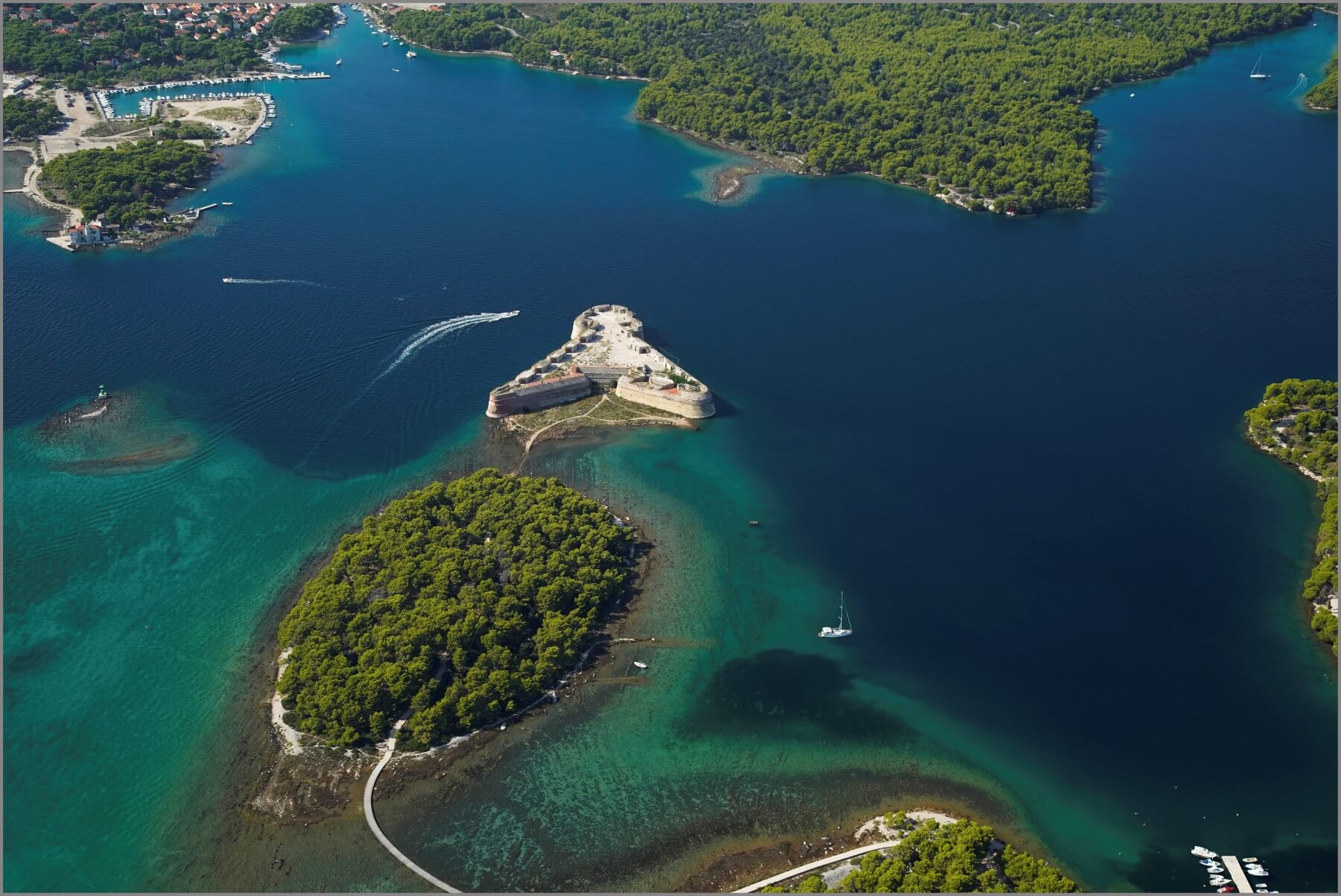 St Anthony's channel, St Nicholas Fortress and the cycle and walking path that reaches it via an island © Šibenik Tourist Board
St Anthony's channel, St Nicholas Fortress and the cycle and walking path that reaches it via an island © Šibenik Tourist Board
In the evenings, during their rest time, active Šibenik's guests have the city's best hotels, restaurants and charming Old Town almost to themselves. They share the cafe, bar and restaurant terraces only with Šibenik residents, relaxing once more now the city is returned to them.
Key to Šibenik's year-round appeal for fitness and sport fans is the city's unique landscape. No place in Croatia has natural assets like Šibenik. It is surrounded on all sides by a remarkable and startlingly varied topography.
Firstly, between Šibenik city harbour and the open Adriatic is a long waterway – St. Anthony's Channel. It is bordered on either side by two huge stretches of wild nature. Then, at the rear of the town, elevated up from sea level and next to Barone Fortress, the area of Šubićevac. Here, the entrance to the vast Šubićevac Forest Park, much of it an untamed, natural landscape. Thirdly, the vast Krka National Park, which lies just 10 kilometres north-east of Šibenik
Active Šibenik: St Anthony's Channel
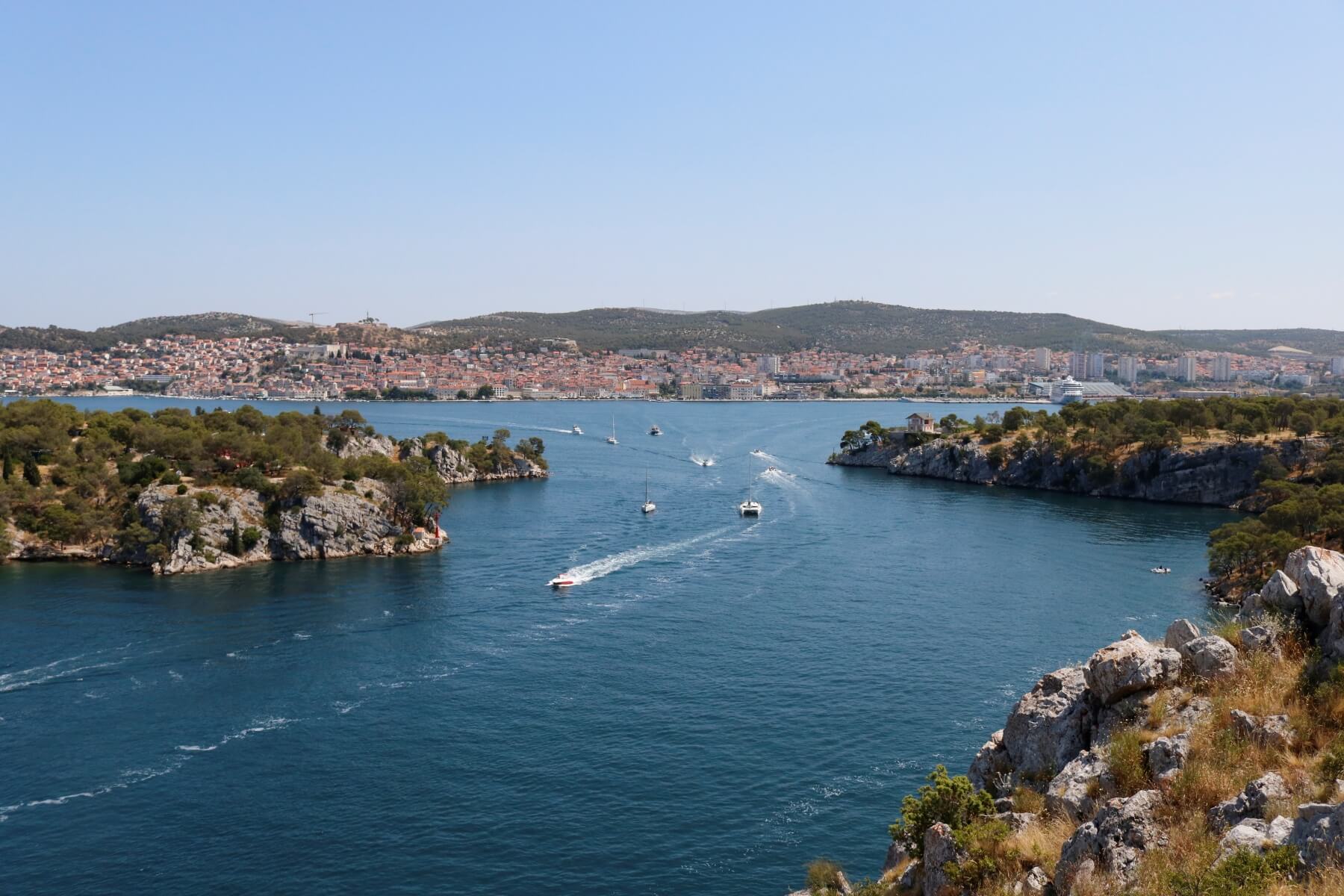
An epic 2000 metre long waterway, St Anthony's Channel is both a gateway to the open sea and the entrance to the city for anyone sailing into Šibenik. It is 140 – 220 metres wide and is bordered on each side by near untouched Dalmatian nature. On one side, sheer cliffs for one wall of the channel. At the top, dense pine forests, walking, hiking and cycling trails. Also, the famous recreation site of Martinska.
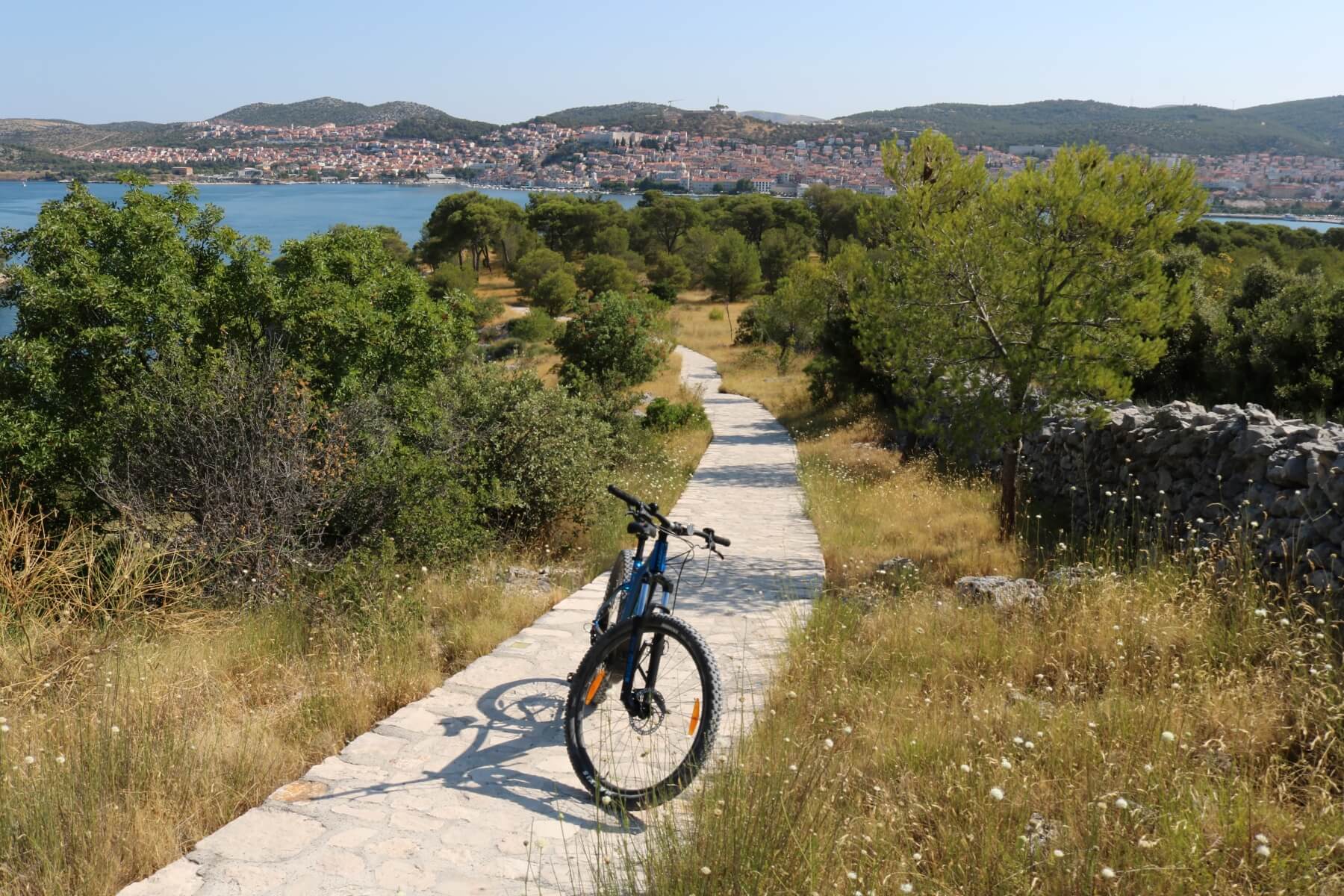
On the opposite side of the channel, a very different layout of the land. Here, the pines are much lower and closer to the channel. Between the two, idyllic beaches - the best in Šibenik – line a pathway designated for running, walking and cycling. Those on bicycles drop down from small hills on the interior. After following the path at the side of the water, their ultimate reward is the spectacular St Nicholas' Fortress. On both sides of St Anthony's Channel you'll see incredible views of Šibenik, its harbour and the side opposite.
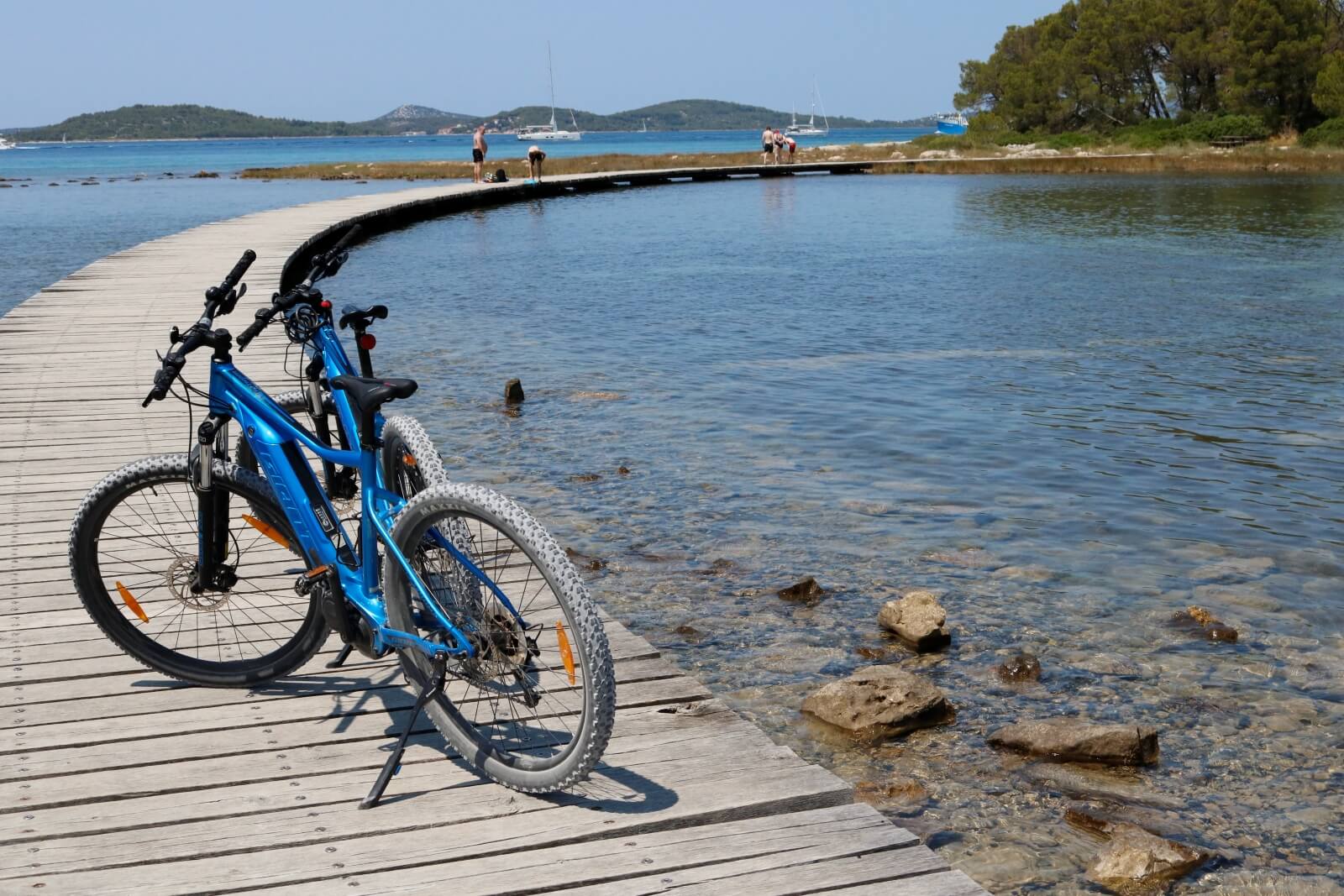
For those who prefer recreation on the water, St Anthony's Channel is perfect to explore by kayak. It's also one of the easiest ways to discover all of Šibenik's best beaches. Sticking close to the pine-sheltered coast, beautiful sailboats pass you in the centre of the channel, on their way to or from the city.
Active Šibenik: Šubićevac Forest Park
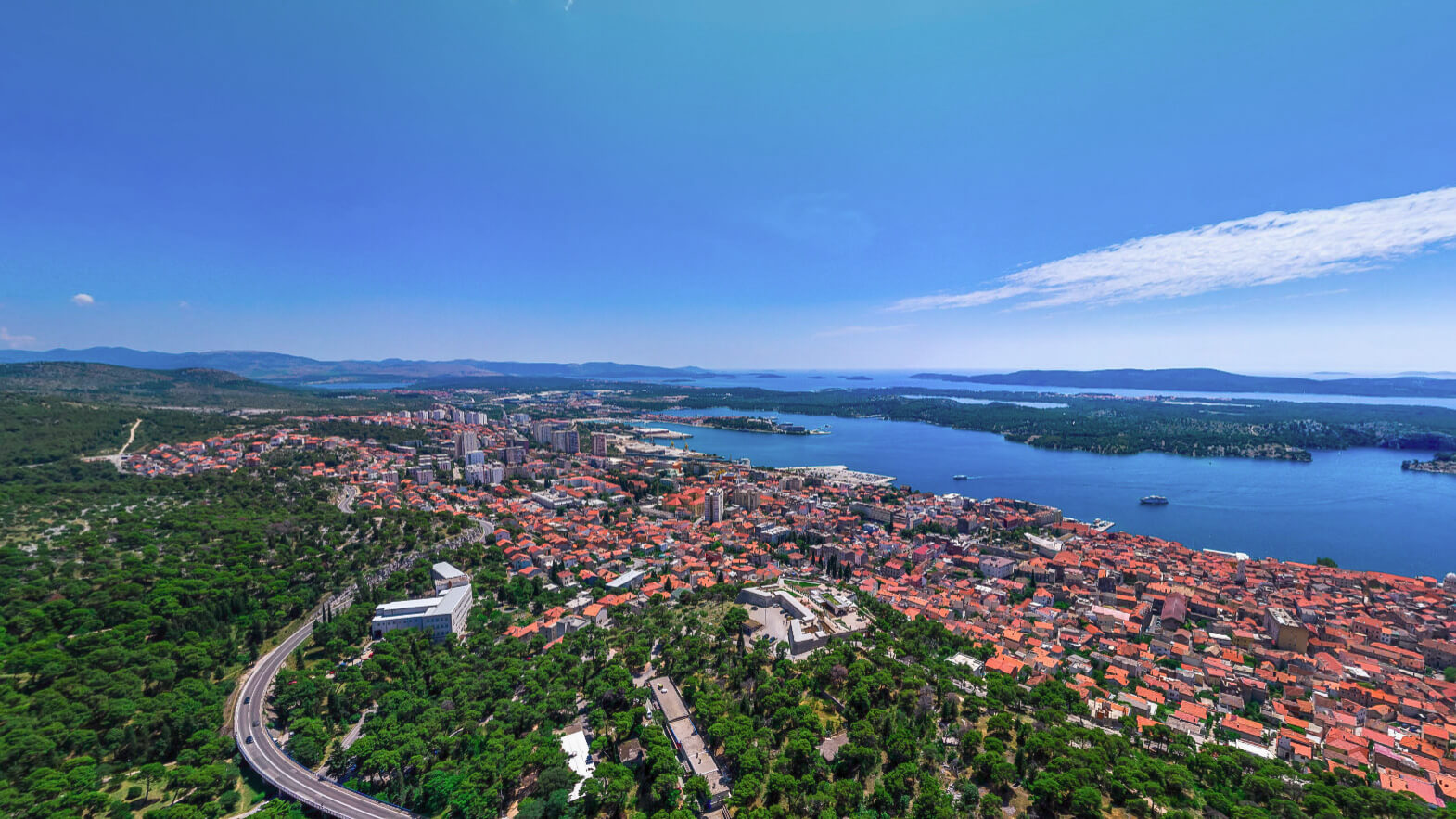 View over Šibenik, with Šubićevac Forest Park at the rear of the city © Šibenik Tourist Board
View over Šibenik, with Šubićevac Forest Park at the rear of the city © Šibenik Tourist Board
To visitors, Šubićevac Forest Park is the least famous of all Šibenik's recreational areas. A huge stretch of forestland, much loved by city residents, it rises above the city near Barone Fortress. The section of forest closest to the Šubićevac is designated as a city park. Within this part, you'll find a children's playground, specially designed to be accessible to all, including children with special needs.
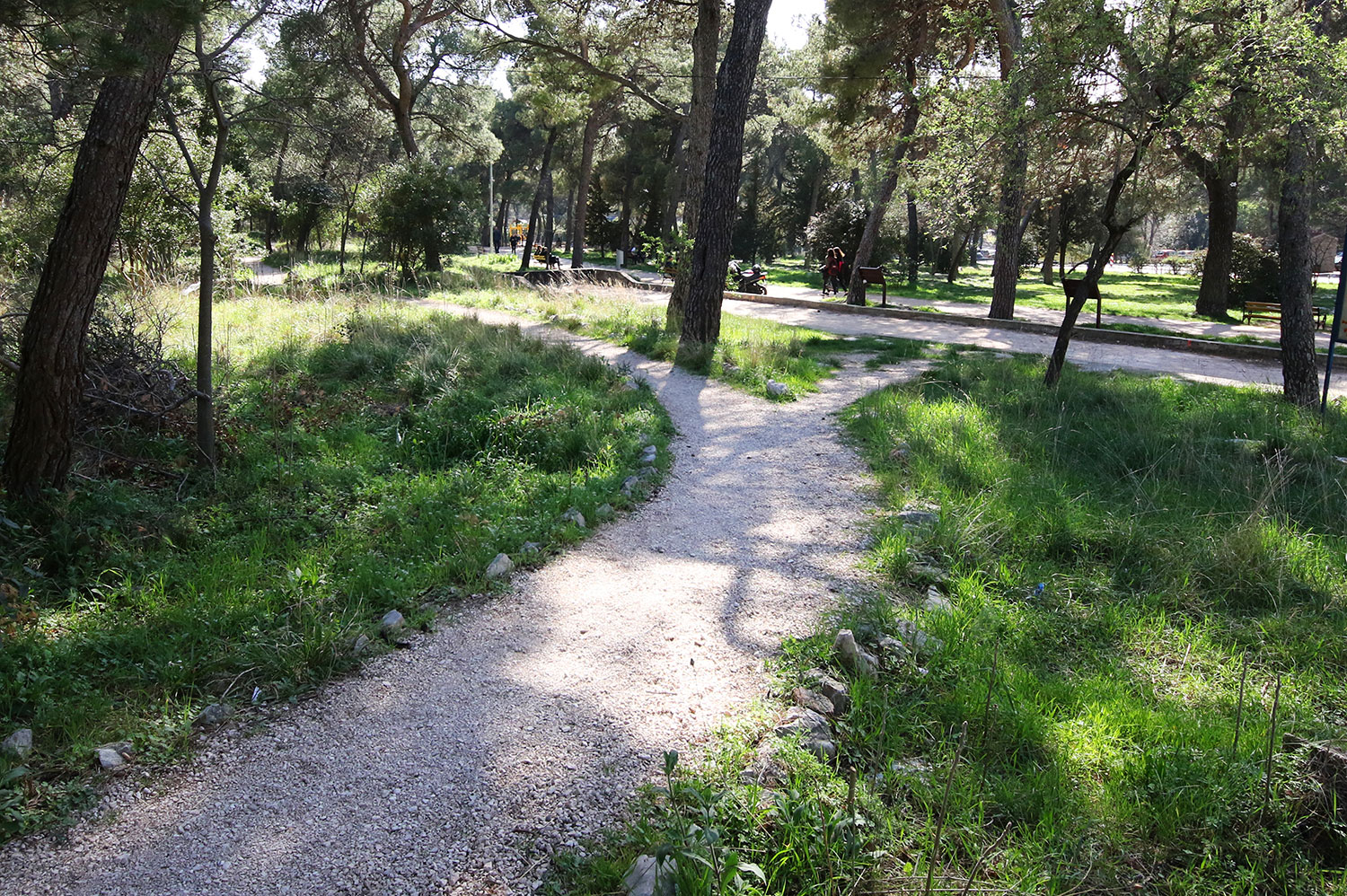 Easily accessible section of Šubićevac Forest Park © Javna ustanova Športski objekti Šibenik
Easily accessible section of Šubićevac Forest Park © Javna ustanova Športski objekti Šibenik
Throughout this section, designated paths for cycling and walking. Running to the southeast, a much larger area of near untouched forest. Here, a wilderness ripe for runners or hikers to explore. It's worth seeking out the tiny Church of St Michael here.
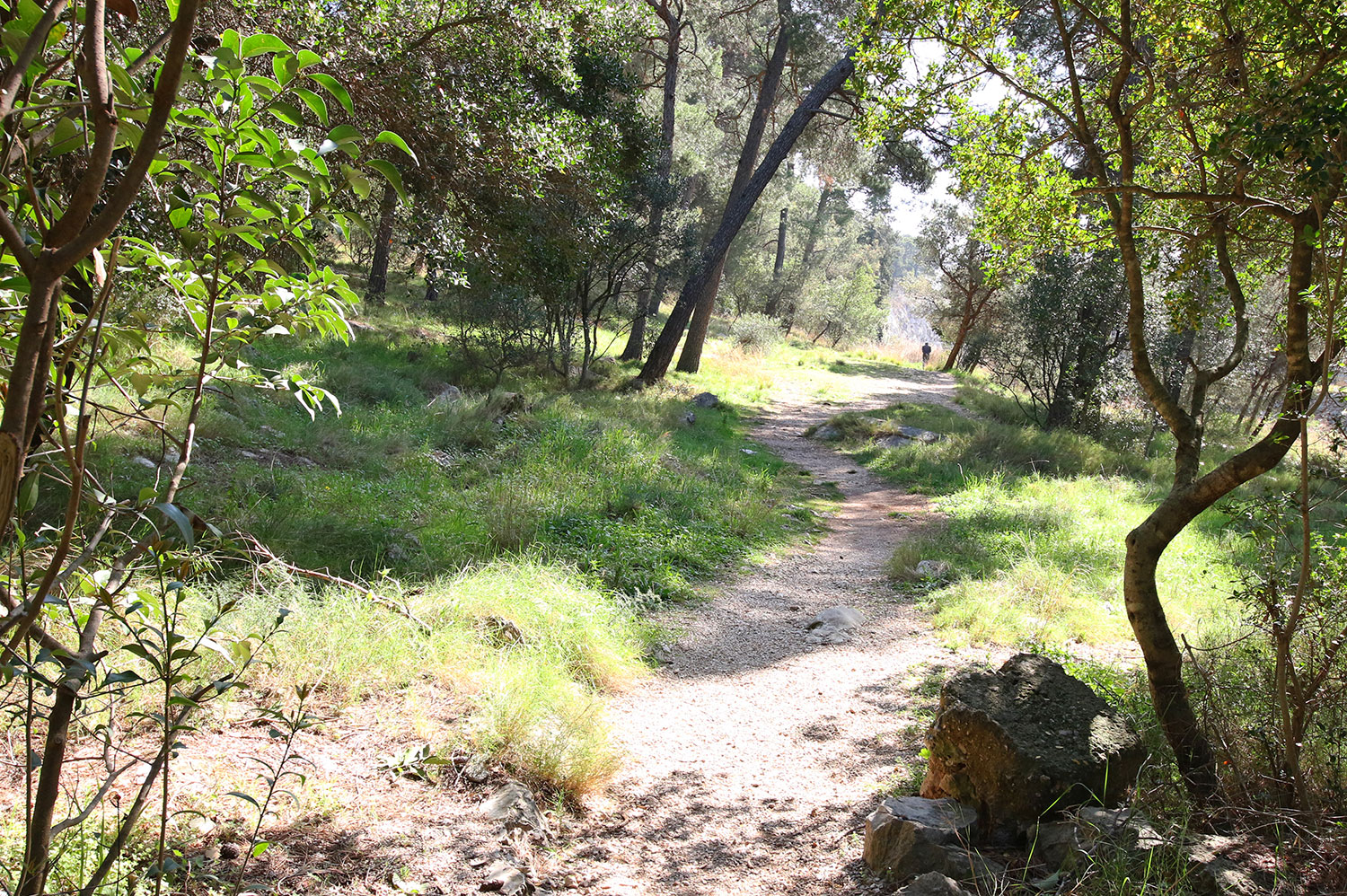 Paths through forest wilderness © Javna ustanova Športski objekti Šibenik
Paths through forest wilderness © Javna ustanova Športski objekti Šibenik
Residents say the very best views of Šibenik come from Šubićevac Forest Park. Certainly, they are breathtaking.
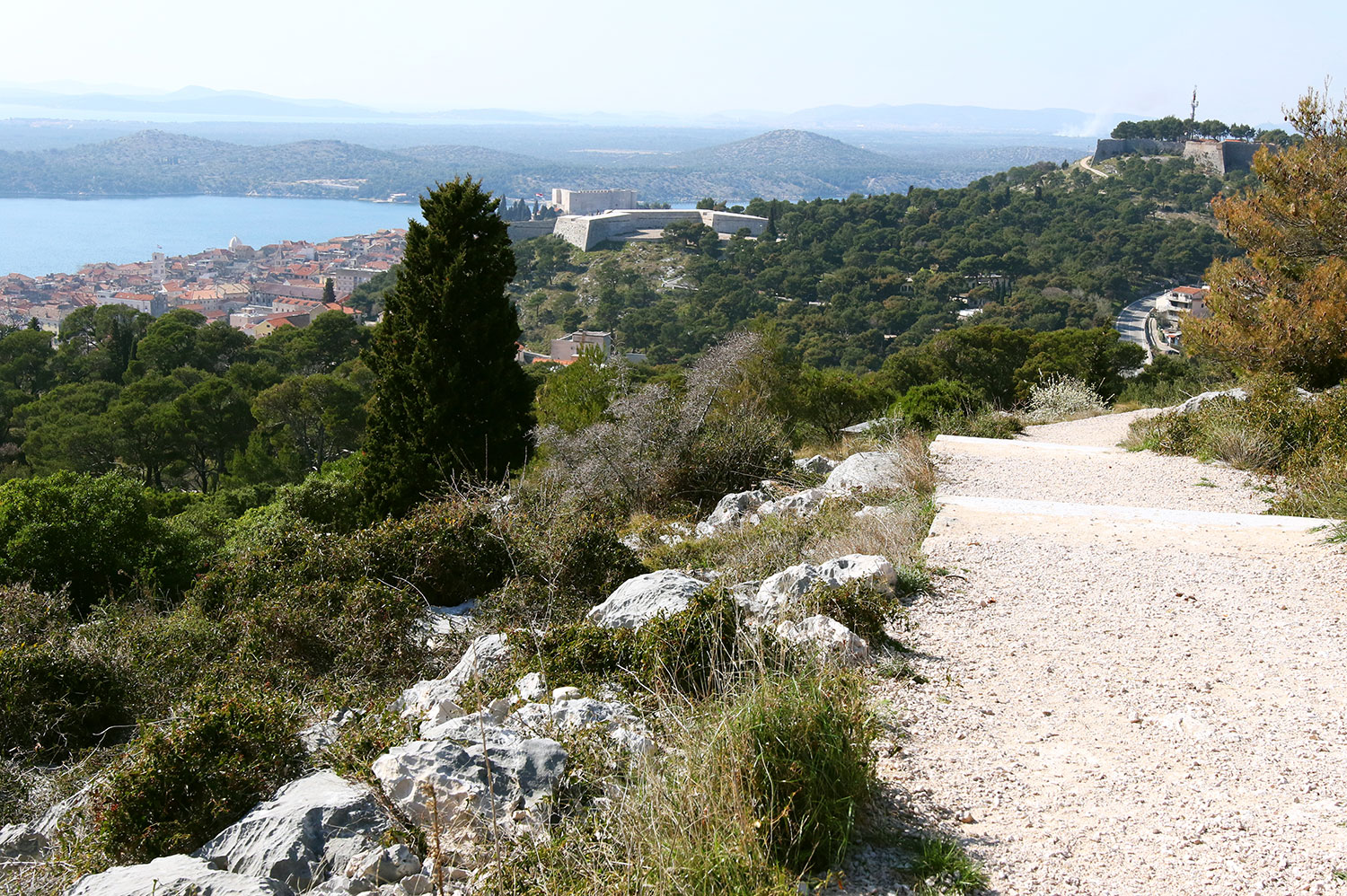 The best views over the city? It's a tough one to call - Šibenik has many contenders © Javna ustanova Športski objekti Šibenik
The best views over the city? It's a tough one to call - Šibenik has many contenders © Javna ustanova Športski objekti Šibenik
Active Šibenik: Krka National Park
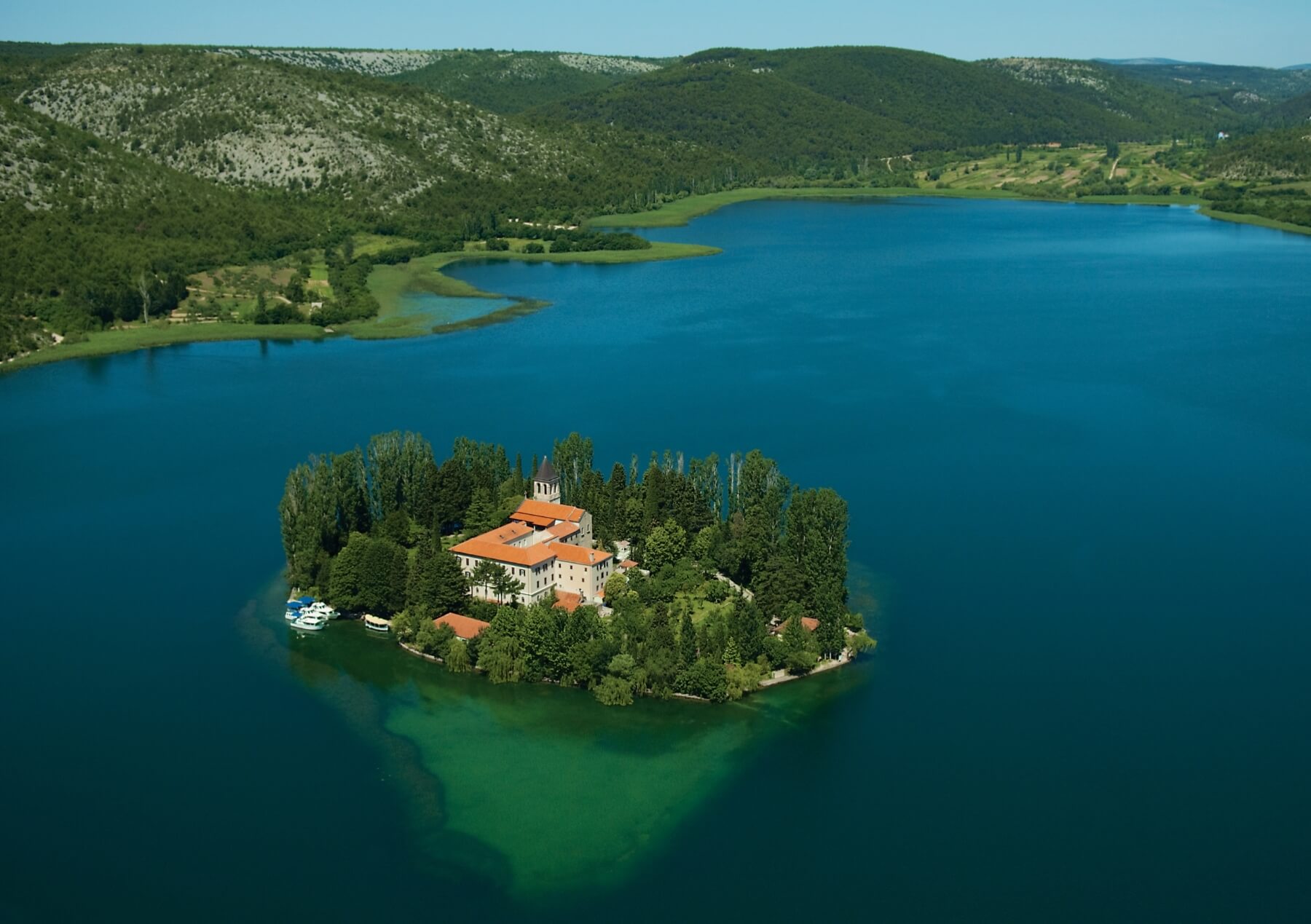 Island in Krka National Park © Šibenik Tourist Board
Island in Krka National Park © Šibenik Tourist Board
A series of wide pools, fed by cascading waterfalls, Krka is one of Croatia’s best known and most spectacular National Parks. Famous water features like the unforgettable Skradinski Buk dominate the park's postcard images. You'll find it near the park's most southerly entrance, very close to Šibenik. But, beyond this eye-catching introduction lies a further 109 square kilometers of spectacular National Park to discover. The best way to experience it is by walking, hiking or cycling.
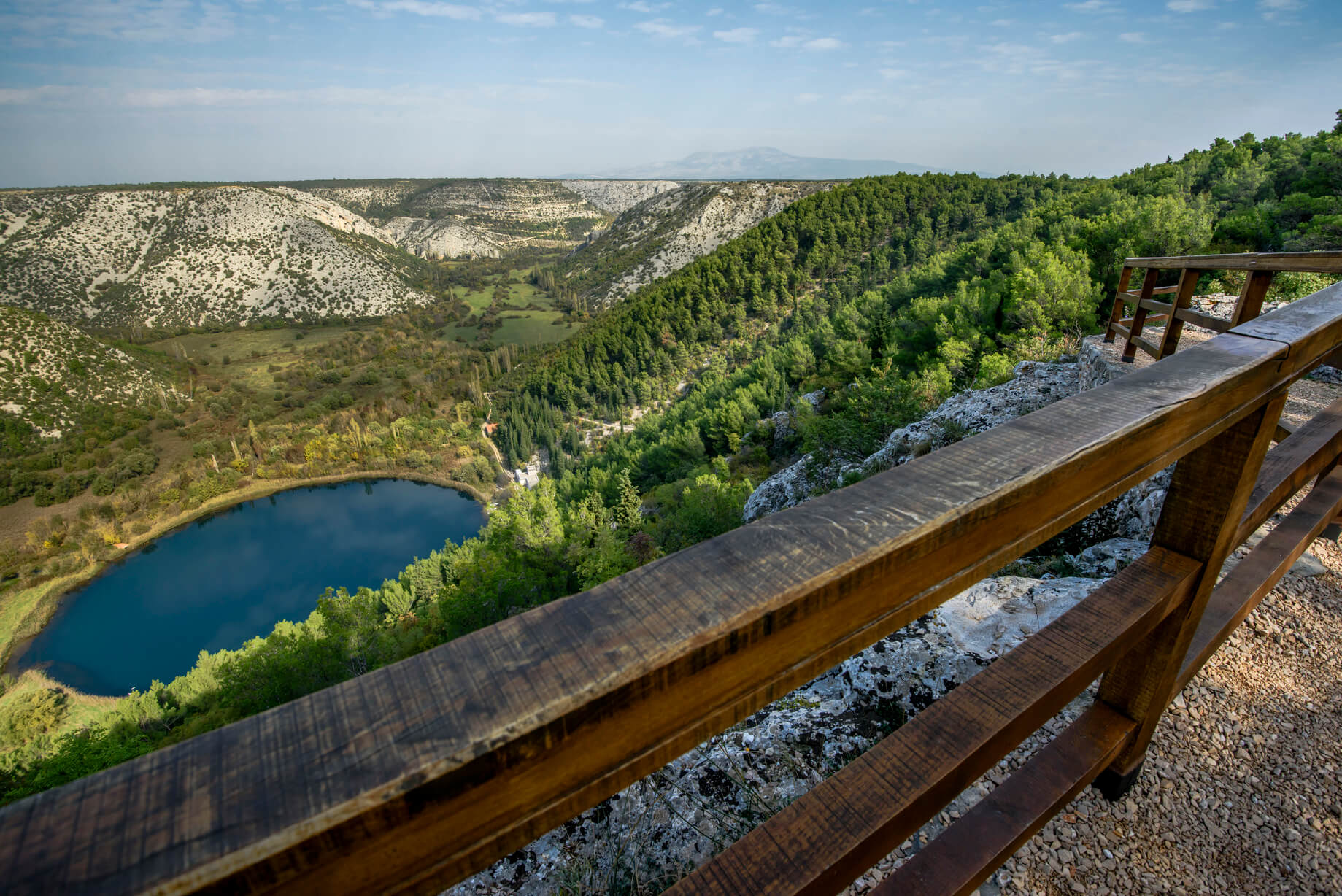 Countless captivating viewpoints © Krka National Park
Countless captivating viewpoints © Krka National Park
Hiking and walking trails of Krka National Park
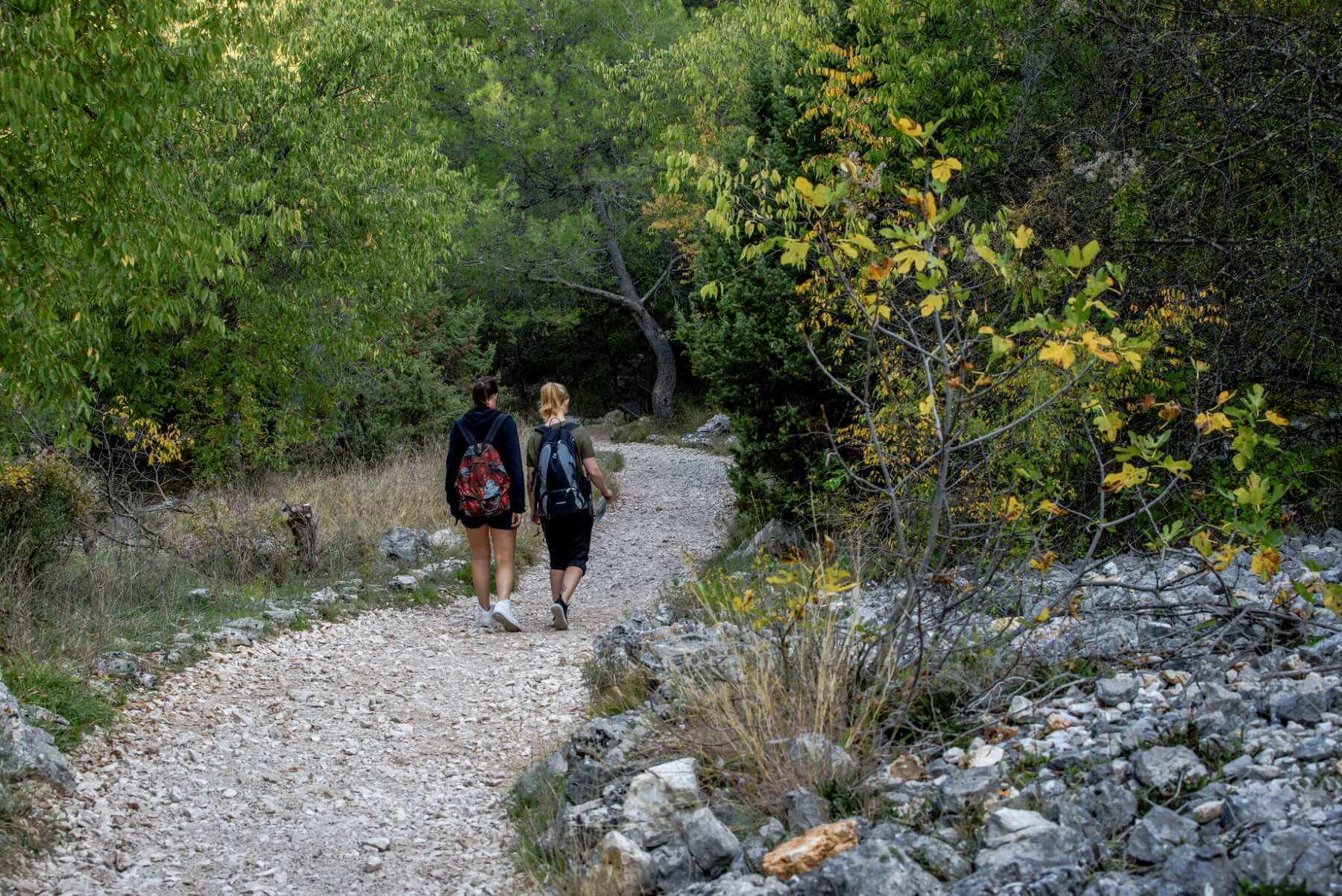 Walking and hiking trails © Krka National Park
Walking and hiking trails © Krka National Park
The park's hiking and walking trails give you the most thrilling views of this epic landscape and its wealth of flora and fauna. At the side of the trails, educational panels detailing the plants and animals you pass.
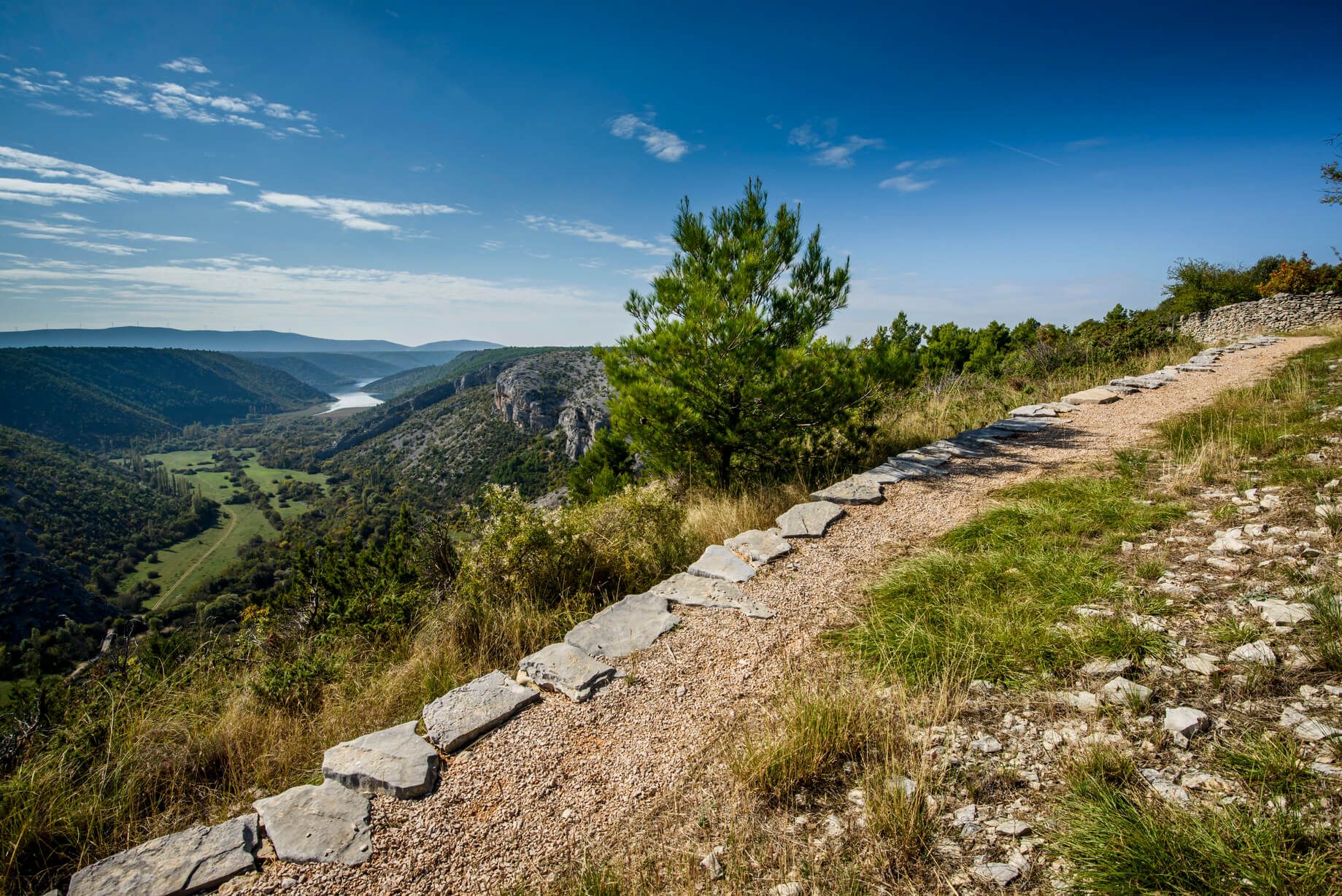 Epic landscape © Krka National Park
Epic landscape © Krka National Park
There are three circular trails: Skradinski buk (1900 m), Roški Slap (1360 m) and Krka Monastery (2100 m). A walking/cycling trail also leads to Skradinski buk from the Skradin bridge (3400 m), while from Lozovac, it is possible to take a forest trail (875 m) down to the park's longest waterfall.
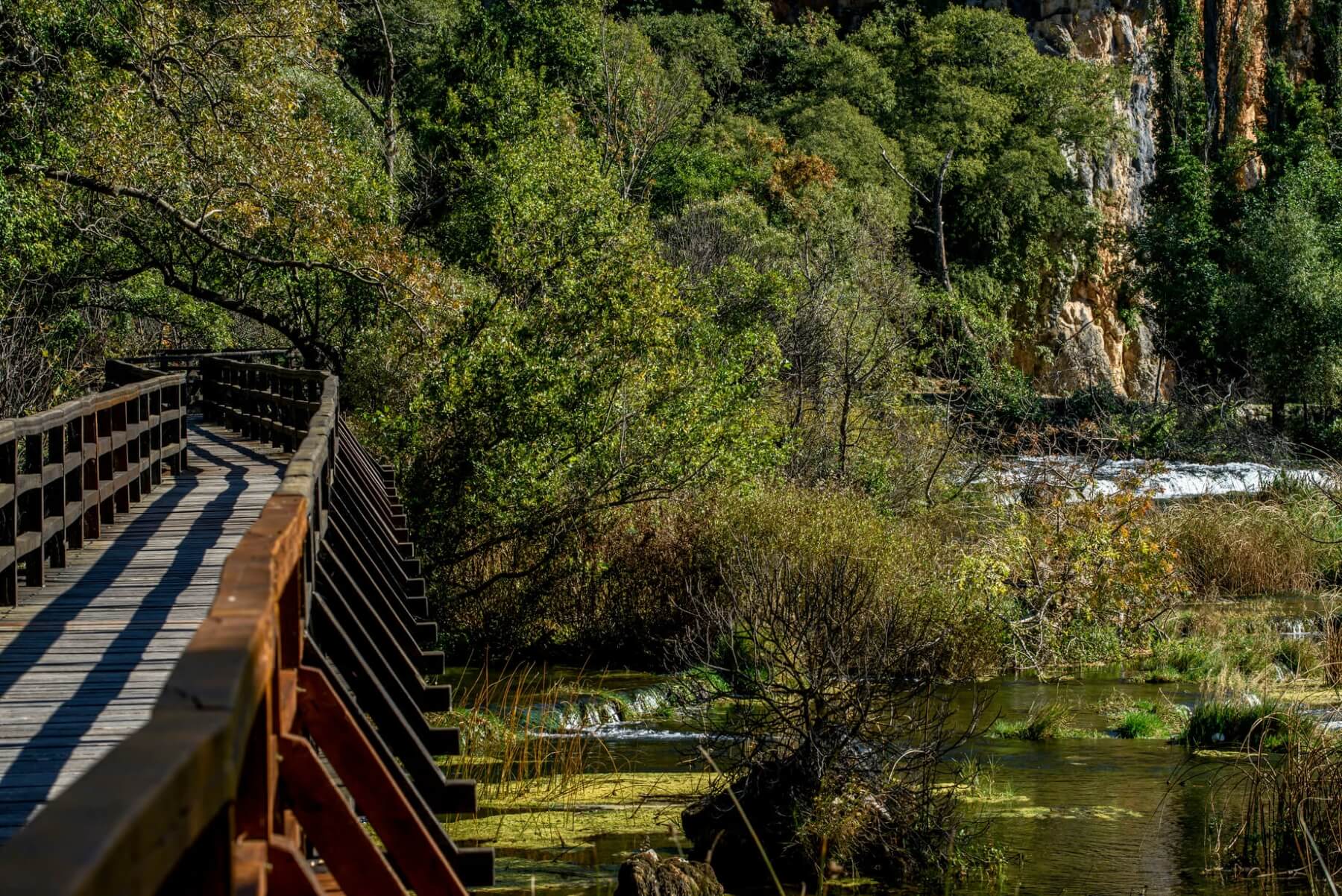 Walking over waterfalls © Krka National Park
Walking over waterfalls © Krka National Park
The shortest trail is 300 m long and leads to Bilušića buk, while the longest trail is Stinice-Roški slap-Oziđana pećina and covers 8.5 kilometres. In total, there are 7 spectacular waterfalls to find as the river Krka descends through the park.
Cycling routes of Krka National Park
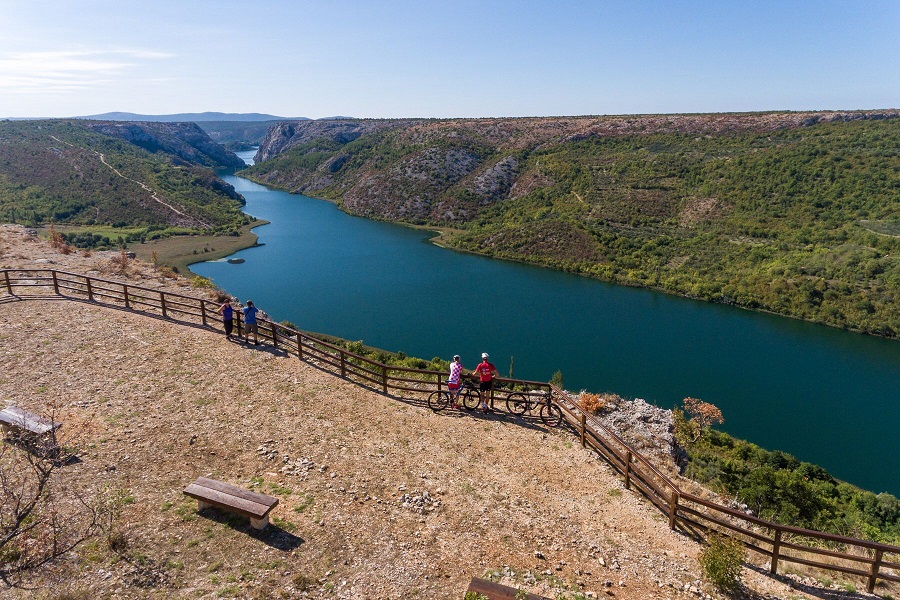 Breathtaking views on the cycling and walking routes © Krka National Park
Breathtaking views on the cycling and walking routes © Krka National Park
Bicycling through Krka National Park is a journey of endless enjoyment. If your perfect cycling route offers stunning landscapes, then this is the place for you. But, if you're curious to learn about the park's cultural and historical heritage, then cycling also helps you unlock these park secrets.
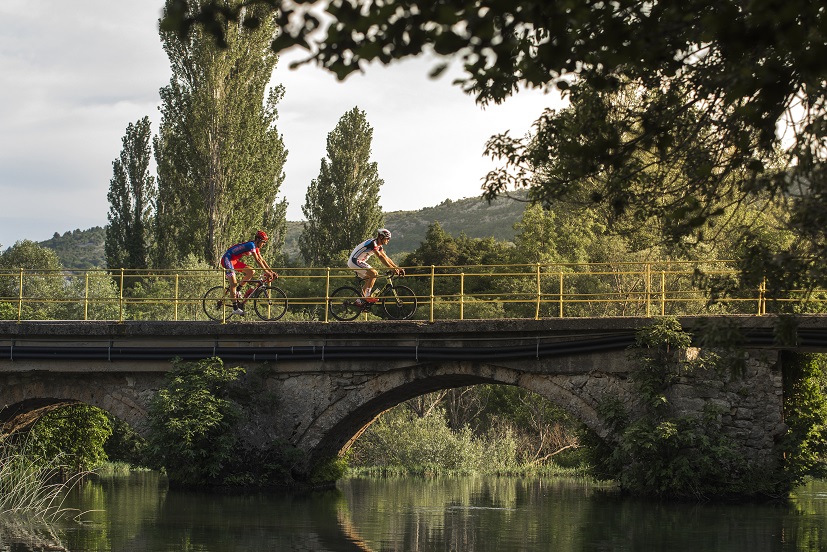 Cycling © Krka National Park
Cycling © Krka National Park
No less than fourteen cycling routes crisscross the park. They are divided into three types:
Road route - perfect for racing bikes and dedicated cyclists
Trekking & family route - a mixture of paved roads and gravel paths, perfect for city bikes, mountain bikes, families with children and cyclists of any age and ability.
Mountain biking route – a mixture of gravel paths and unarranged forest paths, with sharp ascents and descents, designed for mountain bike enthusiasts in good physical condition and with advanced cycling skills.
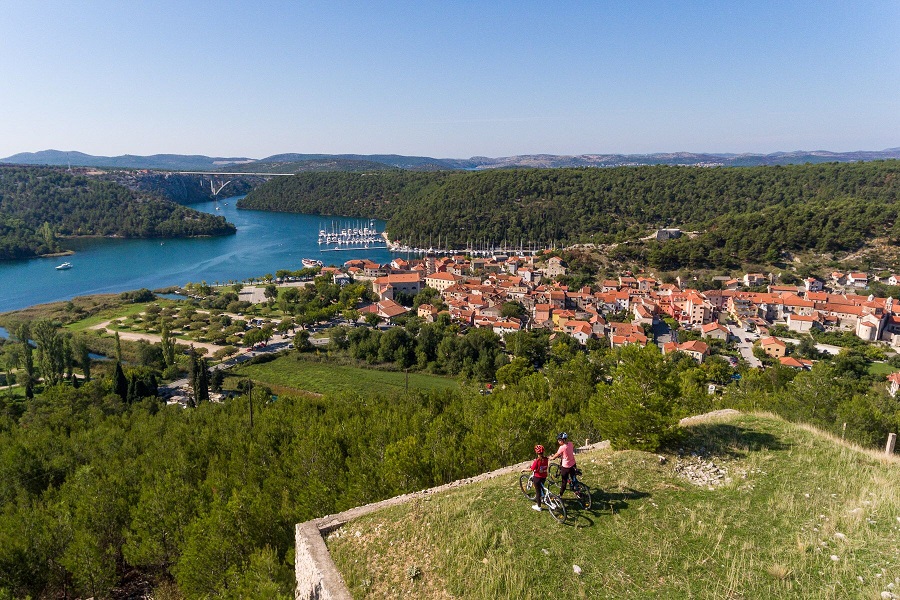 Cycling above Skradin © Krka National Park
Cycling above Skradin © Krka National Park
Šibenik zipline
On the northeast corner of the park, stretching across an epic canyon, one of Croatia's most thrilling ziplines. Flying from cliffs hundreds of metres above, so vast is the canyon that you can barely see the thrillseekers at the end of the first line. And, after that, there are still another two to go!
For more information and/or booking any of these activities, visit/contact Šibenik Tourist Board here
For more on great things to do in Šibenik, be sure to check Total Croatia News's dedicated pages here
Pelješac Interactive Map with Cycling and Hiking Routes Available
May 26, 2021 - As part of an effort to strengthen adventure tourism on the peninsula, a Pelješac interactive map is available with five circular mountain biking routes and six hiking routes.
As stated by turistickeprice.hr, tourist communities from Pelješac united at the end of last year to develop tourist products of Pelješac. Specifically, they approached the development of outdoor offers through hiking, cycling, and windsurfing, and five thematic festivals are planned in which visitors would enjoy the flavors of Pelješac, traditional dishes, and the well-known Pelješac wine.
As part of the development of the Outdoor Program, an interactive map of mountain cycling and hiking routes in Pelješac was made. There are currently five circular mountain cycling and six hiking routes on the map. Additional route extensions are planned, as well as the addition of catering facilities and wineries to the map so that guests can easily find their way around the area and get to know the complete offer of Pelješac. Pelješac is rich in wineries and traditional taverns and restaurants, so the combination of outdoors and traditional flavors is quite natural.
On the map, you can see information about the difficulty of the route, the type of surface, description, photos and you can download the GPX track that can be used in various mobile applications and smartwatches. There is also a link to the OsmAnd mobile app on the map, as a suggestion. Otherwise, the app is free to download and works offline.
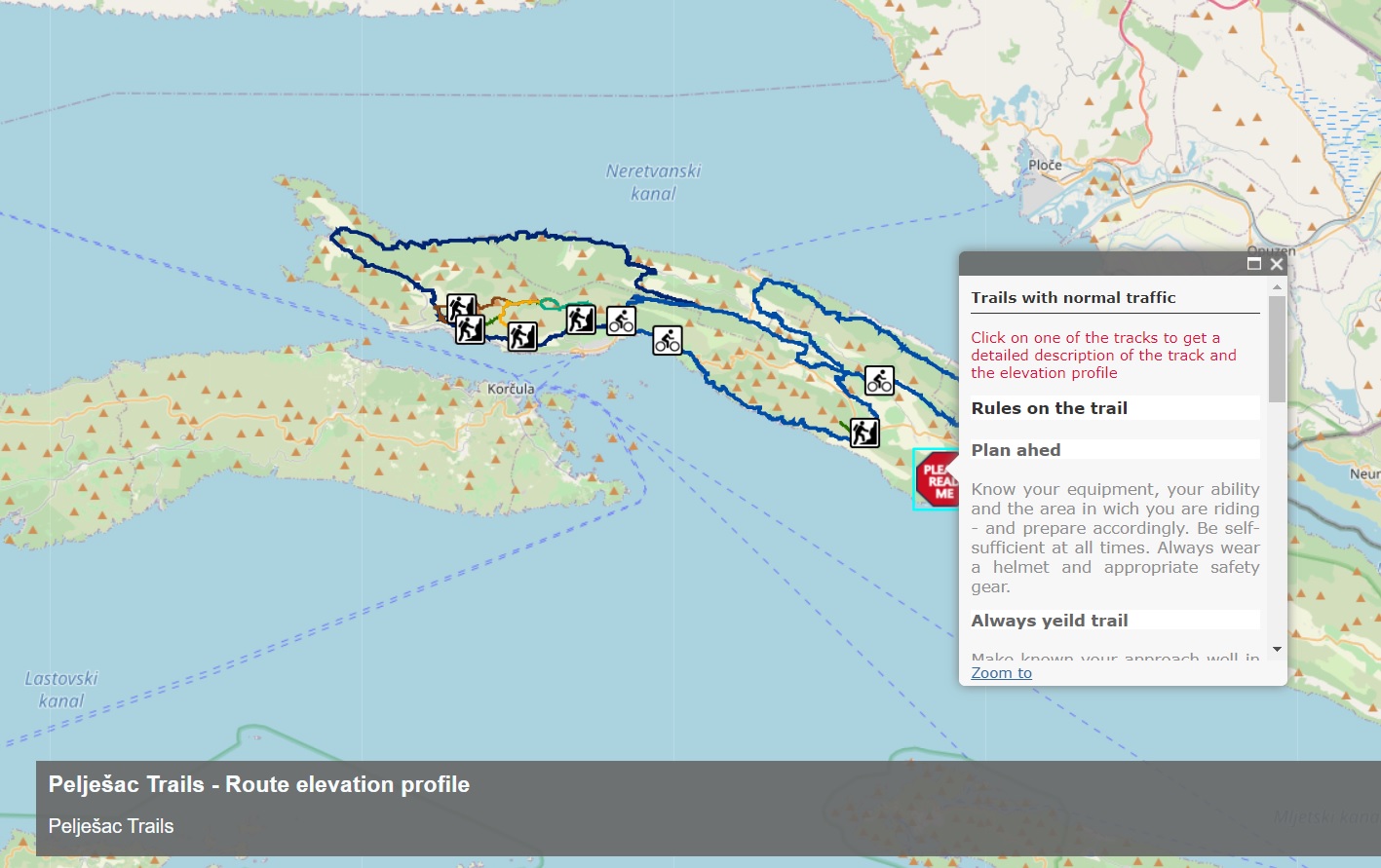
Pelješac Interactive Map with Cycling and Hiking Trails (Screenshot)
The map shows a total of five mountain bike circular routes with a length of 184 km and six hiking routes with a total length of 39 km. The Tourist Boards of Ston, Janjina, Trpanj, and Orebić note that they have developed an interactive map that cyclists and mountaineers can study without coming to the info center, or looking at the websites of tourist boards. In addition, the trails were made in collaboration with local cyclists who know the terrain best, and thus end-users will be able to discover the most interesting parts of Peljesac, which hides many natural beauties.
You can find the English version of the interactive map of Pelješac HERE, and the Croatian version HERE.
You can learn everything about what the Pelješac peninsula can offer you on your next trip, in Total Croatia’s Pelješac peninsula on a page, HERE. Total Croatia’s articles are now available in your language!
For more information about cycling in Croatia, go to Total Croatia's dedicated page.
For more on travel in Croatia, follow TCN's dedicated page.
Croatian Couple Set Off on 1,100 km Via Adriatica Trail to Promote Croatian Beauty
January 22, 2021 – As a New Year's resolution, the Croatian couple decided to set off on one of the longest and most demanding mountaineering ventures in Croatia – the Via Adriatica trail. Starting at Prevlaka, this is their 21st day of walking towards Cape Kamenjak in Istria. Delighted by Croatia's views and the hospitality of the people they met along the way, Josipa and Matija happily make their way through the first long-distance trail in Croatia.
The Via Adriatica trail combines existing hiking trails, forest roads, macadam, and roads in a total of 1,100 kilometers with 41,000 meters of altitude difference. The trail connects Croatia's most beautiful mountain massifs, peaks, and landscapes, stretching from the Istrian peninsula across the Croatian mountain threshold all the way to the Prevlaka peninsula.
As its name suggests, it connects the most attractive Croatian mountain massifs, peaks, and regions along the Adriatic coast. It passes through three national parks, three nature parks, six significant landscapes, three special reserves, and many protected areas.
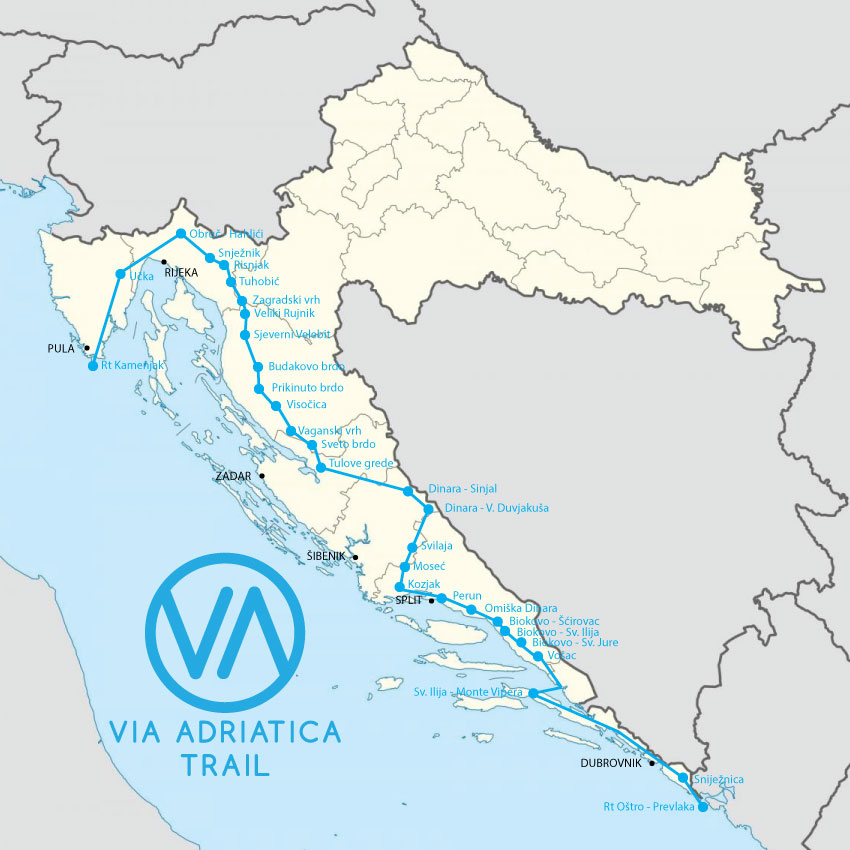
Via Adriatica trail
If we go in concrete figures, Via Adriatica goes along 14 mountains, 12 rivers, two lakes, 18 protected areas, seven counties, and 52 municipalities. What makes this trail attractive and popular among Croatian and foreign hikers are the sea and island views wherever it is possible.
Josipa and Matija, a young romantic couple from Croatia, are now on the way to Svilaja, a mountain in the Dalmatian hinterland. Although sighing from the constant walking with heavy backpacks on their backs, they tell their story of how, when, and why they decided to head to this fantastic Croatian long-distance trail right now, in January.
'We got in the car and left'
Both Josipa and Matija are natives of Karlovac and hiking enthusiasts, chasing each their careers, which allowed them two months of a completely new mountaineering experience due to a combination of circumstances. Josipa (27) has a master's degree in economics, works as a reception manager in one Zagreb hotel, while Matija (25) runs his own business in an adventure travel agency in Karlovac.
In mid-November last year, they discussed what they would do in January and February since there is not much in Zagreb hotels at that time of the year. When Matija was banned from working on December 1, they decided to go on the Via Adriatica trail to promote Croatia, its beauties, Matija's company, but also – themselves.

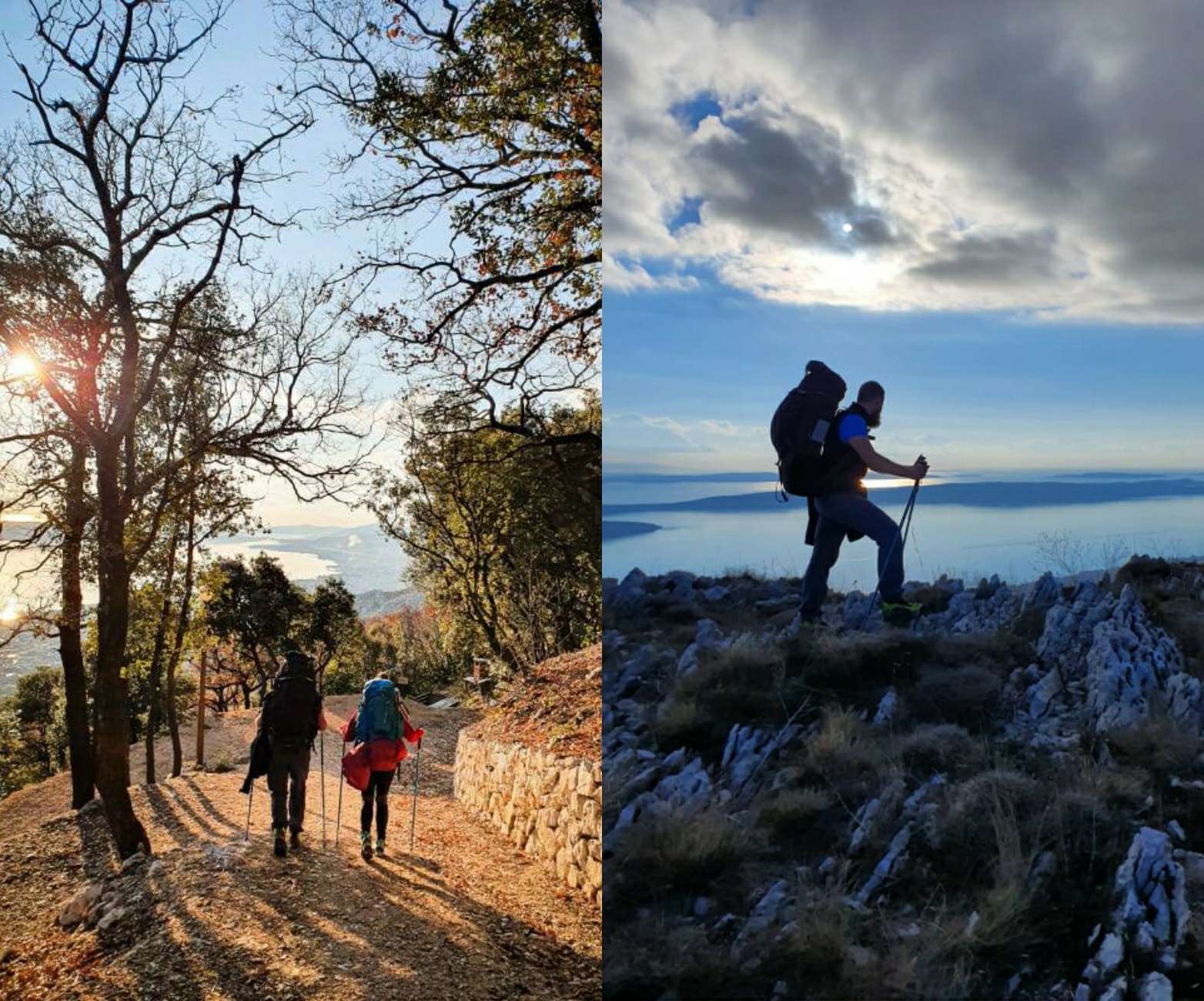
Josipa and Matija, Kozjak mountain
"We have time until the end of February, but we took more time than the average time needed to pass Via Adriatica because we took into account winter and unforeseen circumstances. We already know that we will have to take a three-day break this week due to heavy rain and stormy jugo wind," Matija told the Dalmacija danas portal, which caught up with them in Žrnovnica. They were hosted by the Association Žrvanj, which makes its premises available to all hikers who decide to cross the entire Via Adriatica.
For Josipa, as she says, Via Adriatica was a great idea, but it never crossed her mind to set off on this, not at all simple, but beautiful trail. However, she took advantage of this unique opportunity and, together with her beloved Matija, a member of the Croatian Mountain Rescue Service (HGSS), set off on an adventure.
"In December, we didn't know if we were going to leave or not. There was quarantine, bans, passes. Until the last three days, we didn't know if we were going. Then the earthquake happened, and again it was a question of whether I would go to the rescue or not. Given the time invested in preparation and all the equipment, we said we were going. We got in the car and left," says Matija.
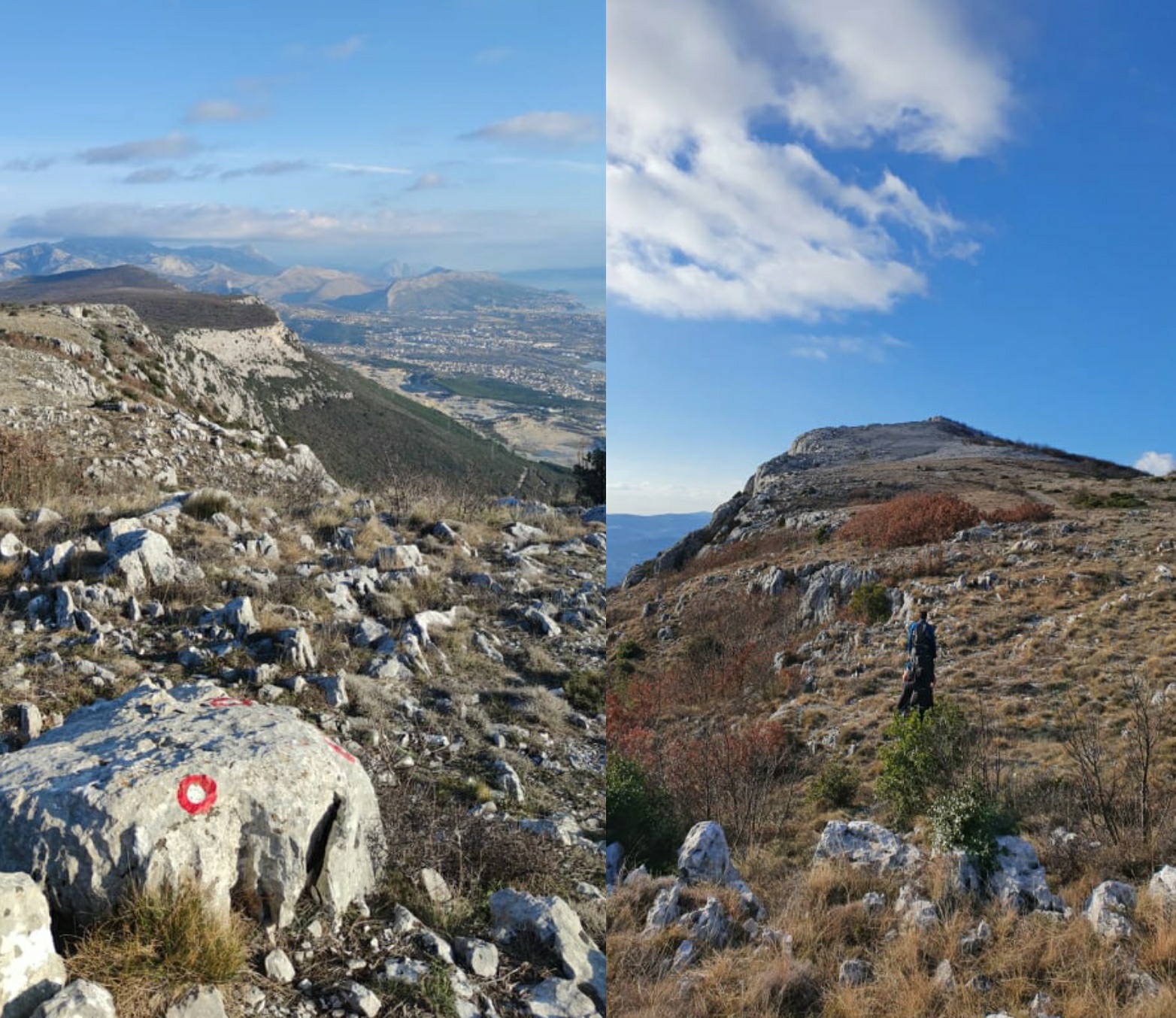
Kozjak mountain
'People make the whole trail special'
Although Via Adriatica starts in Cape Kamenjak in Istria, Josipa and Matija decided to start from the last destination in Prevlaka, to be closer to home in Karlovac at the end of the trail.
"The idea was to be in Dalmatia for the first few weeks, while we have supplies of food and then start getting closer to home. It's more natural to get closer to home than the other way around. We celebrated the New Year, and in the morning, we left Prevlaka," says Josipa.
"The first two or three Via Adriatica's sections are quite flat. When you walk on the flat for a long time, you get bored. Pelješac is beautiful, the view from Sveti Ilija, the highest peak of the Pelješac peninsula, is magnificent, but it takes so long to get there! We only reached the 'real' mountains after Pelješac – Biokovo, Omiška Dinara… Perun has beautiful views," says Matija, emphasizing that the most beautiful parts of the trail are – the people.

On the fifth section, Josip and Matija had good company - members of a mountaineering association
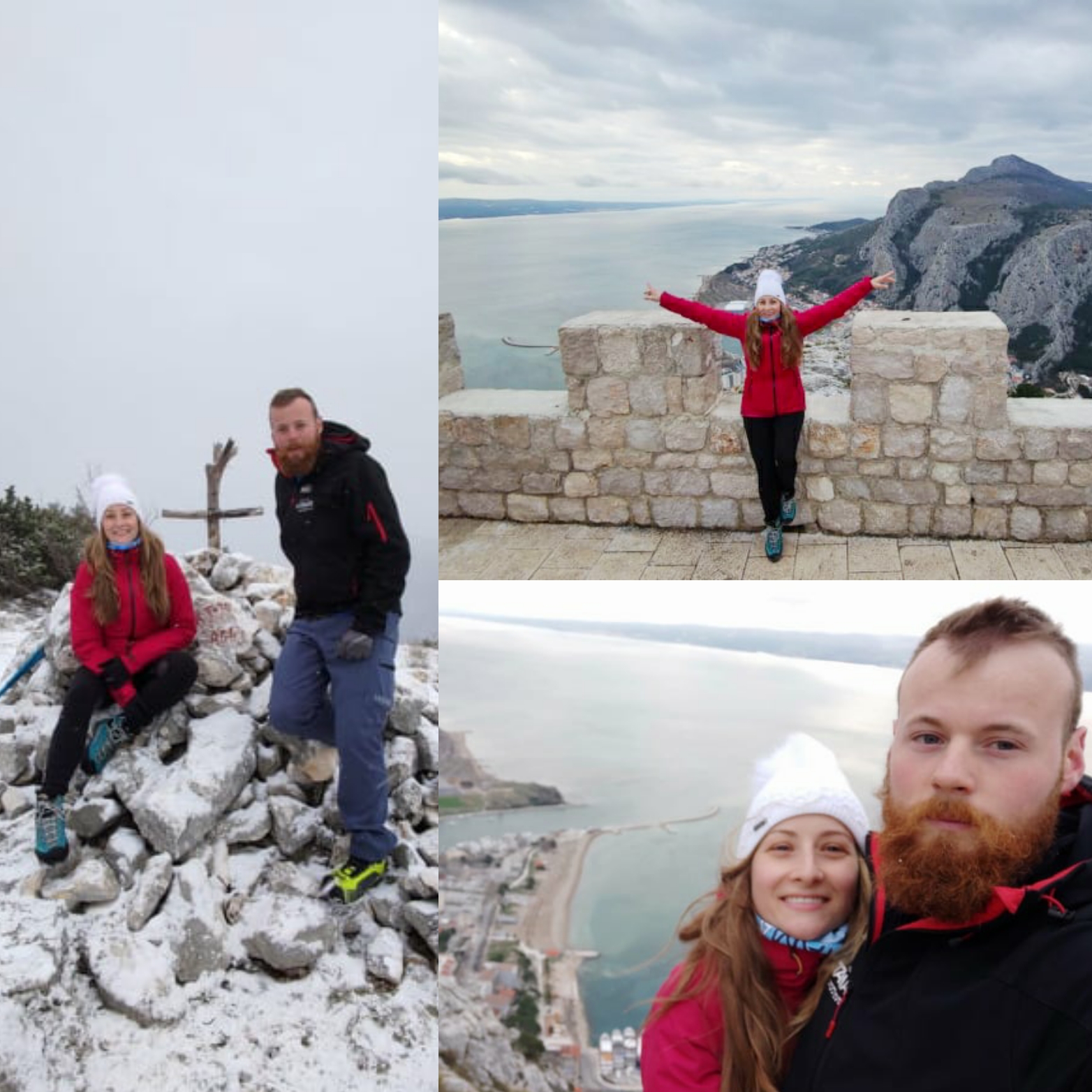
Josipa and Matija at Omiška Dinara
"People make the whole trail special. People selflessly give you their home, food, hospitality. There is no doubt that this path would be five times harder if people did not help. It wouldn't be impossible, but it would be a lot harder. If we had to sleep in the winter in a tent every night, it would not be easy. This way, when you know that warm accommodation awaits you in the evening, you are mentally better prepared. People feed us and take care of us," says Matija.
As they talk to us, they are on the sixth section of Via Adriatica, out of 13. Another 600 kilometers is still in front of them, but they are satisfied with their pace. With a laugh, Josipa says they are breaking through the thorns.
Best views they've ever seen
Before Via Adriatica, they visited Biokovo several times, but always during summer when everything is "stone and heat." They experienced it for the first time in the winter, and they say it was impressive.
"We imagined Biokovo white with huge vastness. And it greeted us exactly like that; icy, white. The weather was perfect; the snow was perfect for walking. We walked in crampons because everything was frozen. Although it was icy and cold, it was sunny, like in a movie. It was snowing on the Omiš Dinara, the large snowflakes falling," describes Josipa.

Snowy Biokovo

View from Biokovo
Then followed Perun or Poljička mountain. Perun, says Matija, is not Biokovo, but it has its charms.
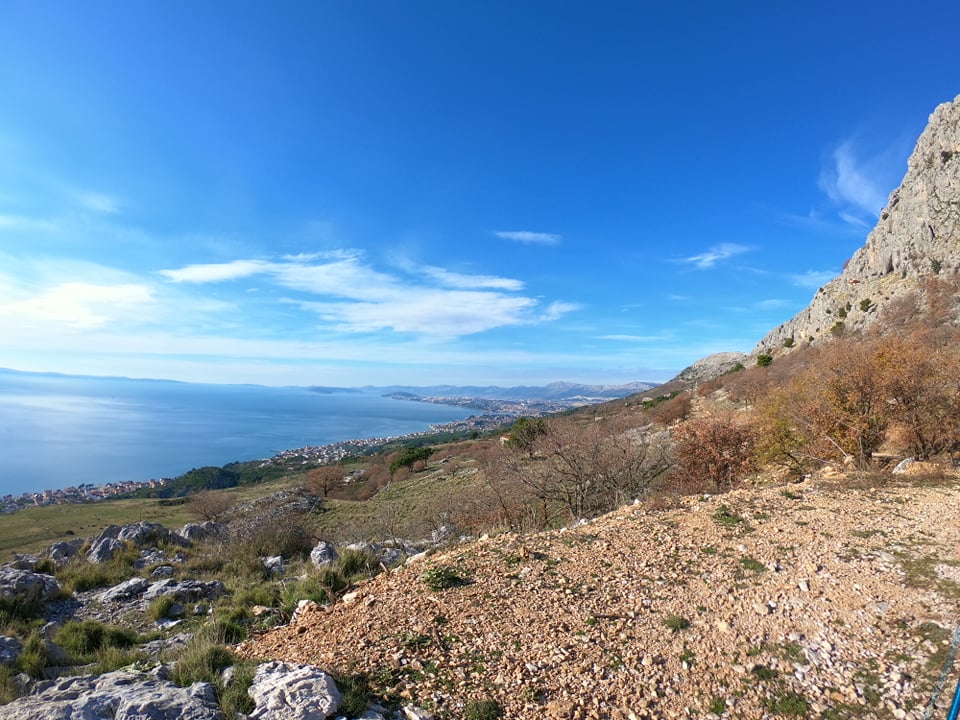


Capturing beautiful moments on their way to Perun
"From Omiš, you go a little towards the village of Gata, so the ascent to the chapels begins, and then descends to the seaside, which is beautiful, with a view of the islands. The moment when Split appears in front of you is especially impressive. So far, I've seen Split from all sides, even from a helicopter, but this is the best view of Split I have ever seen. Brutal," says Matija.
The northern part of Dalmatia - the Dinara mountain, the Lika region, and Velebit mountain - are still waiting for them. The journey is challenging but also exciting.
"Dinara and Velebit are our next challenges. Dinara is quite laid, and I think it will be relatively easy. We know it will all be covered in snow. On Velebit, Vaganski Vrh and Sveto Brdo, two highest Velebit peaks can be quite tricky, especially if those huge cliffs freeze," says Matija, but points out that they are well prepared.
Good equipment is the key
So far, they have not even used all the equipment they brought with them, and they were at a temperature of -15 degrees Celsius with a strong wind. They have high-altitude hiking boots, sleeping bags that can withstand -20 degrees. They also have a real expeditionary Himalayan tent for two, weighing a little less than 4 kilos, wind-resistant over 150 km / h.
"We mostly relied on obtaining quality and safety equipment. Since we travel in the winter, we needed good winter equipment that can withstand low temperatures. I think we did our best in researching for good equipment. We have quality equipment, and we are ready to sleep in winter conditions," says Josipa.
She doesn't check her phone very often, and the signal is lost every now and then, so it's harder to communicate. However, that doesn't bother them – they have each other.

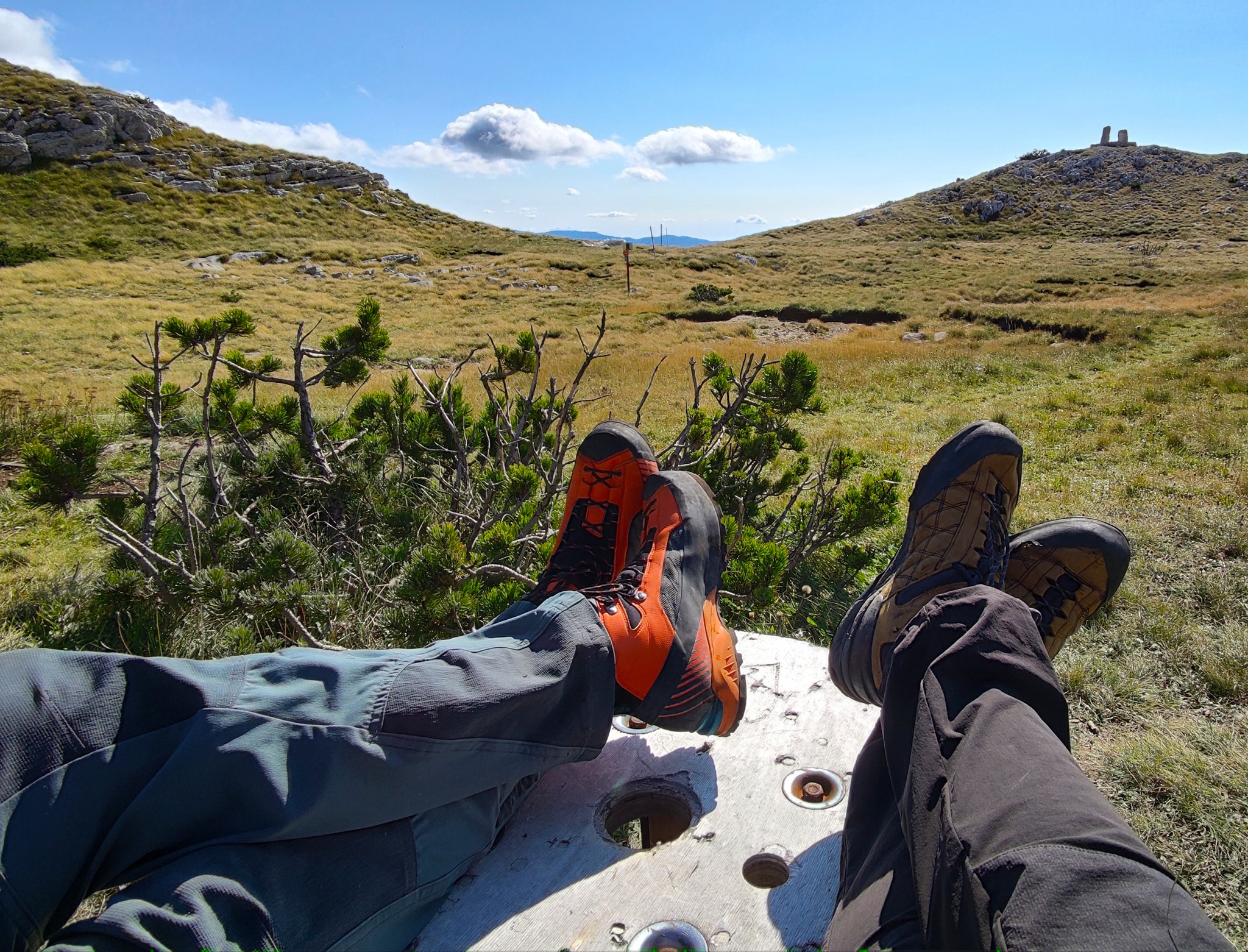
Josipa and Matija
When asked how much it took them physically to prepare for such an endeavor, they say that they are in the mountains every weekend and spend all their spare time in the mountains, so they do not physically prepare too much.
"As for mountaineering life, we are very active. We crossed both easier and harder climbs, both in summer and winter, so we are well prepared. And mentally... I don't think you can mentally prepare for that until you face the path itself. You have some idea what it might look like, but until you find yourself there, you don't know," says Josipa.
Prepare, don't rush, and enjoy the fantastic scenes
And that hiking is becoming a popular hobby in these new circumstances is confirmed by the story of Marin Zovko, who, combining Via Adriatica with the Croatia Long Distance trail, recently walked the whole of Croatia in just 100 days. He decided to embark on his adventure alone and later admitted that loneliness had fallen hardest on him.
Josipa and Matija, more or less, always hike together and often mountaineer in larger groups since they are active members of the mountaineering society. Apart from the company that the hiking companions provide, Josipa says that it is good to hike in the company for safety reasons.
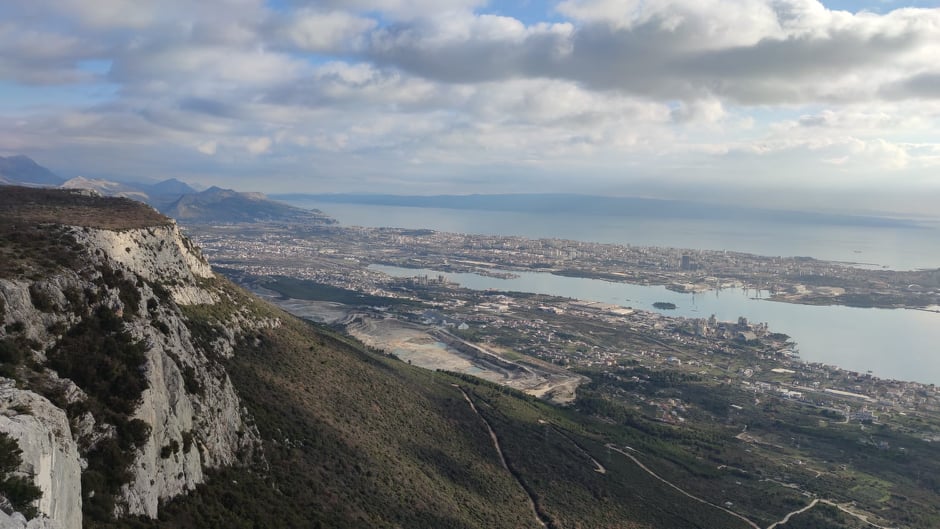
View from Kozjak
"Honestly, I would never dare to undertake such an endeavor alone. Matija knows a lot about the mountains, and since he is a member of the HGSS, we are in safe hands," says Josipa happily.
They recommend people to enjoy the trail, not to rush, but to prepare.
"It takes a lot of courage and a lot of madness to set out on a journey like this, but the trail takes back everything a hundredfold. We watch amazing scenes, and we get to know our country even better. Whoever is interested in something like this, I would recommend it from the bottom of my heart, "says Josipa.
We now let them continue their journey in peace, enjoying all the natural beauties surrounding them because they are quite exhausted due to the Via Adriatica venture's daily demands.
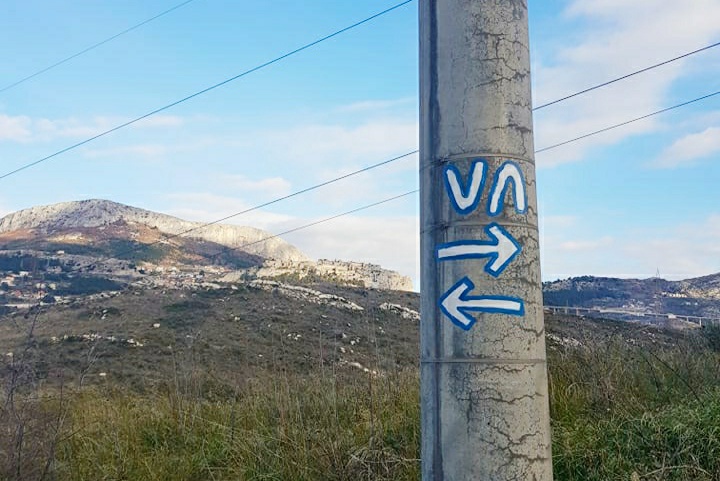
All the photos are from interlocutors' private archives.
To follow more news from their Via Adriatica adventure, you can find them on Facebook.
For the latest travel info, bookmark our main travel info article, which is updated daily.
Read the Croatian Travel Update in your language - now available in 24 languages.
Top 5 Hiking Trails in Dalmatia by Dalmatia Explorer
Where to go for a hike in Dalmatia? Which are the best hiking trails to explore and the most stunning views to enjoy? Dalmatia Explorer knows and gives us his top 5 (read the whole article at the Dalmatia Explorere website):
"Velebit mountain, the mighty Velebit is the mountain we always marvel and respect, and its southern part, the National Park Paklenica does not deserve anything less than adoration.


Biokovo mountain, always tough, challenging and irresistible from whatever direction is headed towards the St. Jure peak. Biokovo sometimes give you an opportunity to look across the Adriatic Sea to the Apennine Alps of Italy and neighbouring countries.


Mosor mountain, the vicinity of the city of Split is one of its comparative advantages, but its diversity and beauty is drawing the attention. It is a sweetheart of all recreational hikers in Dalmatia, while the view of the city of Split and the archipelago of central Dalmatian islands is always amazing.


The island of Brac and its trails, the island of adventure and culture, the island with the highest peak on the Adriatic, Vidova gora. One of our favorite trail starts from the center of the island, from Nerežišće, continuous to the southern slopes and valleys of the island to the cultural gem of the island, monastery and the museum Pustinja Blaca (Blaca Hermitage) ... the path through the history of the Island, pure enjoyment.


Kijevo Kozjak - Kijevo Bat mountain, in Dalmatian inland is the beautiful mountain that offers numerous memorable experiences; enjoying the beautiful trails and nature. Spending some time on Kijevo Bat you will have the opportunity to meet deer on the hiking trail. Arriving at the peak, you will have a wonderful panoramic view of to all major Dalmatian peaks; Dinaric Alps, the highest mountain in Croatia Dinara, the big blue Peruča Lake, and the longest Dalmatian river Cetina."


For more information about hiking in Dalmatia, please contact the experts - Dalmatia Explorer and book one of their hiking packages.


